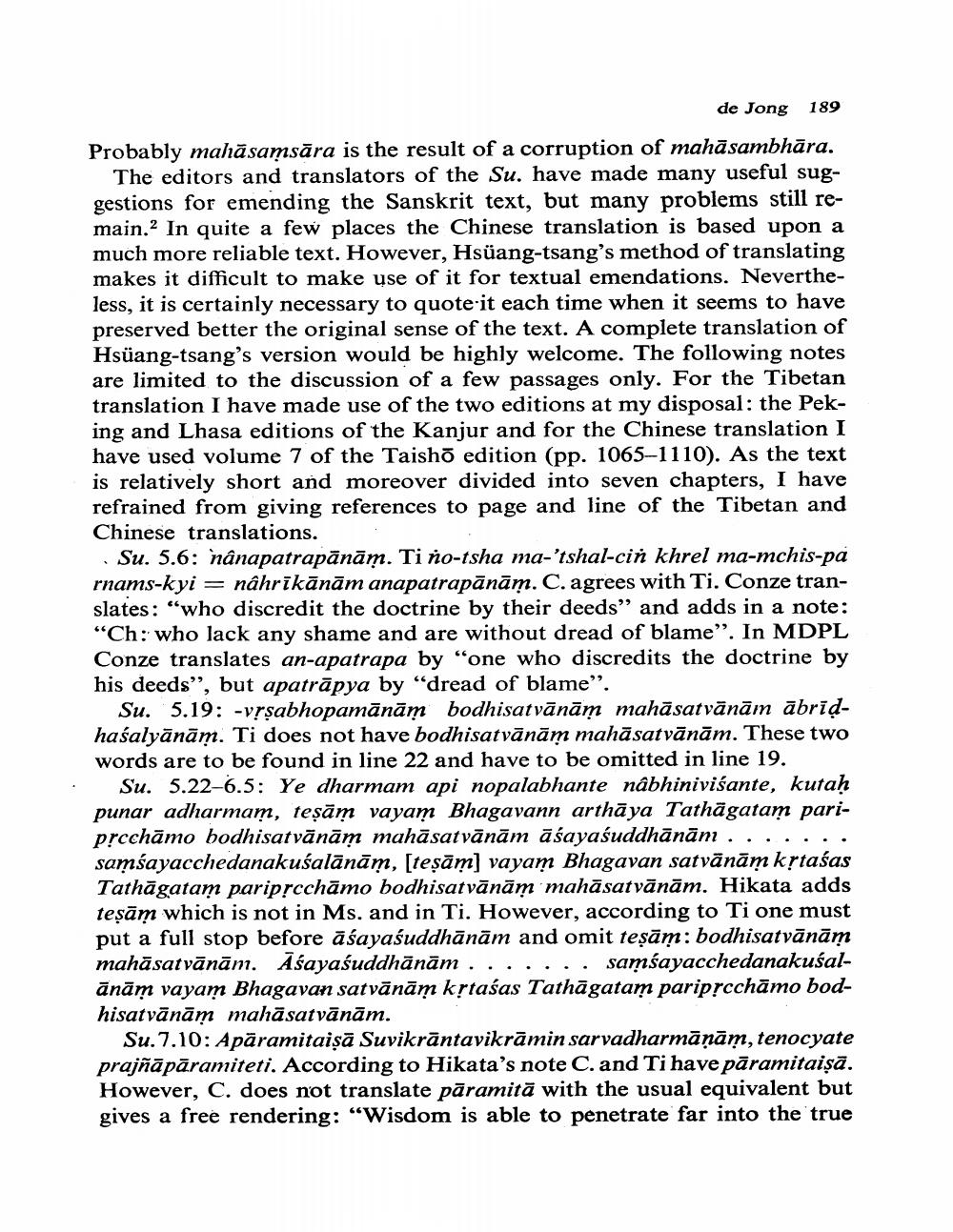Book Title: Notes On Prajnaparamita Texts Author(s): J W De Jong Publisher: J W De Jong View full book textPage 3
________________ de Jong 189 Probably mahāsamsāra is the result of a corruption of mahāsambhāra. The editors and translators of the Su. have made many useful suggestions for emending the Sanskrit text, but many problems still remain.? In quite a few places the Chinese translation is based upon a much more reliable text. However, Hsüang-tsang's method of translating makes it difficult to make use of it for textual emendations. Nevertheless, it is certainly necessary to quote it each time when it seems to have preserved better the original sense of the text. A complete translation of Hsüang-tsang's version would be highly welcome. The following notes are limited to the discussion of a few passages only. For the Tibetan translation I have made use of the two editions at my disposal: the Peking and Lhasa editions of the Kanjur and for the Chinese translation I have used volume 7 of the Taisho edition (pp. 1065-1110). As the text is relatively short and moreover divided into seven chapters, I have refrained from giving references to page and line of the Tibetan and Chinese translations. Su. 5.6: nânapatrapānām. Ti no-tsha ma-'tshal-cin khrel ma-mchis-pa rnams-kyi = nâhrikānām anapatrapānām. C. agrees with Ti. Conze translates: "who discredit the doctrine by their deeds” and adds in a note: “Ch: who lack any shame and are without dread of blame'. In MDPL Conze translates an-apatrapa by "one who discredits the doctrine by his deeds", but apatrāpya by “dread of blame”. Su. 5.19: -vrşabhopamānām bodhisatvānām mahāsatvānām ābridhaśalyānām. Ti does not have bodhisatvānām mahāsatvānām. These two words are to be found in line 22 and have to be omitted in line 19. Su. 5.22-6.5: Ye dharmam api nopalabhante nâbhiniviśante, kutaḥ punar adharmam, teşām vayam Bhagavann arthāya Tathāgatam pariprcchāmo bodhisatvānām mahāsatvānām āśayaśuddhānām ....... samsayacchedanakusalānām, [teşām] vayam Bhagavan satvānām krtaśas Tathāgatam pariprcchāmo bodhisatvānām mahāsatvānām. Hikata adds teşām which is not in Ms. and in Ti. However, according to Ti one must put a full stop before āśayasuddhānām and omit teșām: bodhisatvānām mahāsatvānām. Āśayaśuddhānām ....... samśayacchedanakusalānām vayam Bhagavan satvānām krtaśas Tathāgatam pariprcchāmo bodhisatvānām mahāsatvānām. Su.7.10: Apāramitaisā Suvikrāntavikrāmin sarvadharmāņām, tenocyate prajñā pāramiteti. According to Hikata's note C. and Ti have pāramitaişā. However, C. does not translate pāramitā with the usual equivalent but gives a free rendering: “Wisdom is able to penetrate far into the truePage Navigation
1 2 3 4 5 6 7 8 9 10 11 12 13
